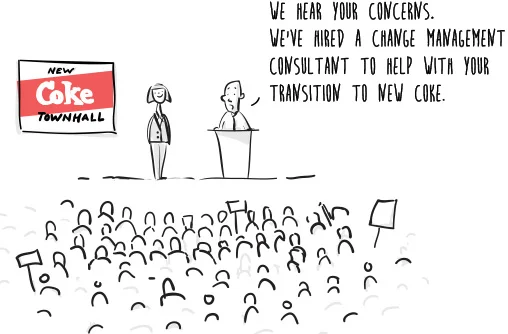Why You Should Treat Employees More Like Consumers
Amid the beverage wars of the 1980s, Coke decided they needed to get a leg up on Pepsi by retooling their iconic Coca-Cola recipe. New Coke was introduced in 1985 and immediately met with hostility. Despite poor focus group results and endless phone calls, Coke said they were committed to the new recipe. Protest groups formed and petitions circulated calling for a return of the classic flavor. Coke didn’t have a choice. In the summer of 1985, they announced plans to bring back the nearly century-old recipe.
Coke made, arguably, one of the greatest consumer product mistakes in history, but ultimately recovered by listening to the consumer.
Ideas are hard to force on people. No amount of marketing would have convinced consumers New Coke was better than the old one. Consumers have to be enticed with something they find valuable. That’s where design comes in. Good design can lead consumers to embrace a change or a product willfully. This realization has made design a key focus across industries. Design-driven businesses are outperforming counterparts by 228% indicating good design impacts consumer adoption.
When it comes to organizational change, companies rely on a different philosophy. New structures, processes, and systems aren’t designed to be willfully embraced. Instead, they are enforced through hierarchy and control. Concerns towards change are rarely seen as signs of a poor strategic decision, but rather symptoms of the fact that “change is hard.” The solution is more communication, not a recantation of the decision. In the corporate environment, feedback opposing Coke’s decision would have been met with communication like...
“We hear your concerns. New Coke is really important to the future of our business. We ask that you remain positive during this time of transformation.”
What if consumers called the hotline and the phone representative said...
“I understand you’re frustrated, but maybe you’re not familiar with all the good things New Coke has to offer? Did you know it has a smoother taste?”
To the public, those messages are business suicide. Inside a company, they’re called change management.
EMPLOYEES AS CONSUMERS
The psychology governing the behaviors and attitudes of employees is the same psychology influencing consumer behavior. In an age where the best talent have more options, employees are seeing themselves as consumers in the job marketplace. Our commitment to a job is about as strong as our commitment to a phone carrier. 60% of the millennial workforce is open to seeing other people, and 93% of those who leave do so for something entirely different.
Options are the reason consumers have power. Employees are beginning to feel this same sense of power.
EMPLOYEE EXPERIENCE IS CONSUMER EXPERIENCE
It’s true the relationship between employee and employer is different than the company and consumer relationship. Changes are forced on employees largely because they can be. For many, it’s perceived as the only thing that works. BUT, the internal approach doesn’t have to be so different from the external one. We acknowledge the need to spend millions on marketing to entice consumers while at the same time we tell employees their compensation is competitive in the industry. No one ever closed a sale with the line, “we’re competitive in the industry.” In the end, both are reciprocal relationships, and crafting the best-possible consumer and Employee Experiences start with that truth.
As the incoming workforce begins acting more like consumers in the job marketplace and the sense of scarcity has less influence over engagement, it will become essential to approach the Employee Experience with a design mindset. Workplaces like Facebook and Google have been experimenting with employee experience for years. Their influence has sent a wave of open floor plans and cool furniture into companies who, otherwise, would not have thought those elements important. Companies that pursue an Employee Experience as well-crafted as the customer experience could do a better job of enticing talent, inspiring workers, and creating meaningful workplaces for the next generation at the same time they see the clear business gains from adopting a design focus.


